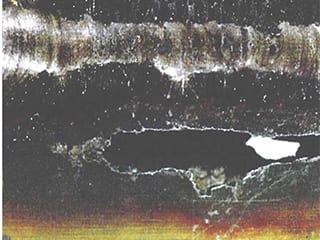
Aberdeen Branch, Latest News
Branch News Aberdeen Branch
Following on from the success of its week long April joint webinar event with MCF, ICorr Aberdeen held its 8th event of the 2019/2020 session during 6-10 July 2020 with a very comprehensive marine focussed ‘Webinar Week’ comprising of some excellently delivered papers by:
• Roger Francis, (RF Materials – Improving the Corrosion Resistance of Duplex Stainless Steel Welds).
• Adnan Syed, (Cranfield University – Hot Corrosion Mechanisms for Gas Turbines).
• Lars Lichtenstein, (DNV GL – Improvements of the DNVGL-RP-0416 and DNVGL-RP-B401 – Upcoming Revisions).
• Brian Wyatt, (Corrosion Control Ltd – Cathodic Protection of Offshore Renewable Energy Infrastructure).
• Andrew Woodward and Chris Matthews, (Connector Subsea Solutions Ltd – Use of CRA’s in Mechanical Connectors for CRA Clad or Lined Pipe Repairs).
The heavily over-subscribed webinars, which had more than 500 attendees, were jointly chaired by Phil Dent (MCF) and Stephen Tate (ICorr-ABZ), with Lewis Barton (MCF) as webinar facilitator.
This time around, a very effective 4-pronged promotional attack was deployed, with excellent Social Media blogs provided by Michael Barton for the HQ website, Dr Yunnan Gao promoting at the Aberdeen end, Lewis Barton via the MCF website and LINKEDIN pages, and further additional support provided by Gareth Hinds and Brian Wyatt of ICorr Council.
There was excellent participation by the attendees via Web Chat for all the Q&A Sessions, and all the presenters’ responses are also now loaded onto the ICorr/MCF websites.
All the webinar presentations had excellent technical content that highlighted the particular challenges of the marine environment, in terms of correct materials selection, correct application of corrosion control methods, the importance of good quality control at fabrication, and having appropriate inspection and maintenance regimes.
Roger Francis discussed in great detail the development of modern Duplex stainless steels from the early 1980’s onwards, with particular emphasis on the jointing processes / joint design and how to avoid corrosion failures of welds resulting from disturbed metallurgy, the importance of having adequate post-weld treatments / checks, (such as post-weld pickling / use of shielding welding gases during fabrication and the use of Feritscope checks on the HAZ of production welds that can be used to measure the ferrite content through magnetic induction), and in also having suitable weld testing programmes in place at fabrication stage, over and above that of ASME IX, and he proposed some suitable tests. Roger also emphasised the need to perform corrosion tests not just on the PQR (Procedure Qualification Record), but also based on the individual welder qualifications, in order to ensure that each welder fully understands what is necessary to produce an acceptable’ weld quality.
Adnan Syed described a very interesting journey through hot corrosion mechanisms of jet engines and industrial gas turbine components, (this being a well-known issue for the aviation and power generation industries). The talk included the possible hot corrosion mechanisms occurring in the gas turbine combustion environment, and some of the challenges industry is facing in their understanding and managing of turbine component degradation. He discussed the two main types of attack: Type I (high temperature corrosion) attack, in the range of 750 to 900 C, mainly due internal sulphidisation, and Type II (low temperature hot corrosion) attack, at temperatures in the range of 600 to 750 C (maximum rate of attack in the range of 675–730 C) and associated with pitting type attack. The importance of good alloy quality and the prevention of corrosion damage related to salt deposit chemistries was emphasised, along with ongoing Cranfield laboratory corrosion experiments and the use of thermodynamic software to help identify the phases formed, which in turn enables a better understanding of the mechanisms involved
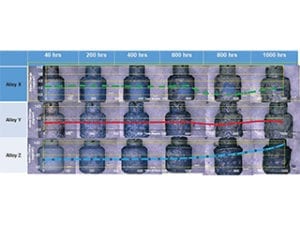
Cranfield University – Adnan Syed. Examples of macrographs and mass change data for high temperature corrosion testing.
Lars Lichtenstein then considered the harsh operating environment for Marine Wind Turbines being increasingly deployed in our coastal waters, bringing us up to date on ongoing revisions to DNV GL documents on corrosion protection for wind turbines (which are under internal revision), DNVGL-RP-0416 and DNVGL-RP-B401. Changes highlighted included more guidance on the useful coating lifetime as introduced in DNV-OS-J101:2011 for the first time, and the relation with fatigue calculation and surface preparation, including the need for weld grinding. In particular the level of coating quality required at the end of the lifetime, and the degree of effort needed to be put into inspection and repair of 15+ year old coating systems, so as to ensure ongoing integrity. Lars also discussed the issue of coating breakdown factors with regards to CP system calculation and on current drain of buried structures. He further highlighted new information on material selection for bolts and stainless steel, and what boundary conditions should be considered.
Brian Wyatt nicely linked into the previous day’s discussion on standards and recommended practices and emphasised the multiple zones / environments requiring many different corrosion control considerations / solutions within the Wind Energy Sector.
He highlighted the lack of competency seen in some projects performed to date and gaps in guidance that urgently require to be addressed as the renewables industry accelerates in scale. Velocity effects are a particular consideration resulting in increased levels of oxygenation at the steel/water interface which demand more robust CP designs, both in mechanical and electrochemical terms. The nature of the support structures, and limited scope for lower cost onshore anode installation, also lead to challenges to uniform anode distribution, particularly on Monopile type structures that replaced the earlier jacket type wind farm structures, that were more similar to the established requirements and practices of the Oil and Gas Industry, for which earlier DNV Codes were intended to cater for (editor, see technical article later in this magazine).
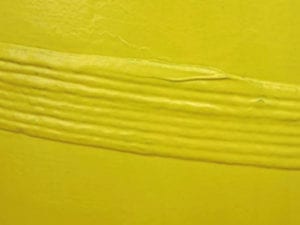 Andrew Woodward and Chris Matthews wrapped up the week with a great talk on outcomes from their recent joint industry project (JIP) with Chevron and Woodside Petroleum, as part of a new technology development programme in line with DNVGL-RP-A203. They have recently developed a new patented method of sealing on the inside of a CRA clad or lined pipe, thus enabling a permanent subsea repair solution. The new seal in the “CLiP” Connector takes advantage of the corrosion resistant and ductile properties of Alloy 625 (UNS N06625) and experience gained through extensive testing of graphite in order to create a seal that conforms to NACE MR0175 / ISO15156-3. The seal forms around all pipeline manufacturing tolerances and even localised irregularities such as internal weld seams. The seal can be easily integrated into existing mechanical connector configurations and is able to be adapted for both diver installed and remote repairs. The technology qualification was completed through a combination of analysis (including development of a parametric FEA model to cover all future design scenarios), 3rd party material testing, and component testing in specialised test rigs; all culminating in full scale testing within a mechanical connector. The presentation focussed on the analysis and testing aspects of the technology qualification process which highlighted all key failure modes that had to be addressed.
Andrew Woodward and Chris Matthews wrapped up the week with a great talk on outcomes from their recent joint industry project (JIP) with Chevron and Woodside Petroleum, as part of a new technology development programme in line with DNVGL-RP-A203. They have recently developed a new patented method of sealing on the inside of a CRA clad or lined pipe, thus enabling a permanent subsea repair solution. The new seal in the “CLiP” Connector takes advantage of the corrosion resistant and ductile properties of Alloy 625 (UNS N06625) and experience gained through extensive testing of graphite in order to create a seal that conforms to NACE MR0175 / ISO15156-3. The seal forms around all pipeline manufacturing tolerances and even localised irregularities such as internal weld seams. The seal can be easily integrated into existing mechanical connector configurations and is able to be adapted for both diver installed and remote repairs. The technology qualification was completed through a combination of analysis (including development of a parametric FEA model to cover all future design scenarios), 3rd party material testing, and component testing in specialised test rigs; all culminating in full scale testing within a mechanical connector. The presentation focussed on the analysis and testing aspects of the technology qualification process which highlighted all key failure modes that had to be addressed.
There has been much debate of late concerning the impacts of the coronavirus outbreak, but the success of these recent Joint and Online Events has proven beyond doubt that such obstacles can be overcome and that the thirst for corrosion learning remains as strong as ever.
As usual, full details of future branch events can be found on the ICorr Website, or by contacting: ICorrABZ@gmail.com, and copies of the majority of past branch presentations can be found at: https://www.icorr.org/aberdeen/ and a photo gallery for all Aberdeen events may be found at: https://sites.google.com/site/icorrabz/event-gallery. See also ICorr Aberdeen on LinkedIn at https://www.linkedin.com/in/aberdeen-icorr/.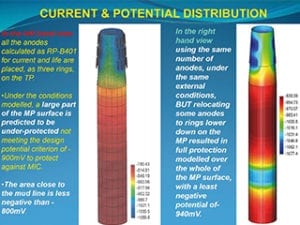
It should be noted that the planned ‘Industrial visit (Oceaneering), an “Alternative / Interactive Industrial Event’, will now take place on 25th August 2020, and readers should also be aware of the upcoming Aberdeen joint event with TWI on 24th September 2020 covering Environmental Corrosion of Fasteners. More details of both events will follow soon on the ICorr website and social media. All of Aberdeen’s remaining 2020 events will be Online.
Brian Wyatt – Corrosion Control Ltd. Example of Advanced CP Modelling used to optimise Galvanic Anode Positioning.
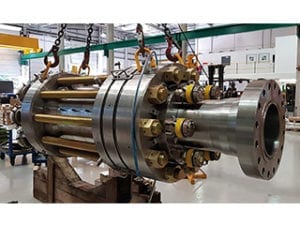
Connector Subsea Solutions Ltd – Andrew Woodward and Chris Matthews. An assembly showing the use of CRA’s in subsea clad pipelines and repair of connections. DNV GL approval was awarded to the CRA clad and lined pipe end seal in December 2019.
Latest News
The Corrosion Science Symposium is one of the premier events in the Institute of Corrosion’s calendar. This year it’s not going to be quite the same as before, but we think you’ll like what we’ve done to ensure it is an equally engaging and enlightening an event as it has always been. The key to its success, as ever, is those who
attend – you.
The CSS has traditionally been a two-day meeting held in a prestigious location befitting of its status, and last year’s event was held as part of Electrochem 2019, at the University of Strathclyde’s Innovation Centre in Glasgow.
Although it is an informal meeting of the CSD in which corrosion scientists, corrosion engineers and PhD students can gather, hear talks on corrosion, and discuss relevant corrosion issues, it does include certain formalities. Presentations of some of the Institute of Corrosion Awards are made during the CSS, including the presentation of the UR Evans Award – the premier scientific award of ICorr, and the Lionel Shreir Award – for the outstanding student talk given during the CSS.
With a more unpredictable future than at any time in our history, the CSS has been moved from a physical space to cyberspace this year. While the exact format is still being finalised, the date and an outline of the format have been set. As it’s going online, rather than an intense two days of sitting in front of a screen, it is being extending to three or four sessions during the week beginning 14th
September 2020.
The exact format, times, and technology being used will be announced nearer the date. One thing is for certain, though – being online, the CSS will be more accessible this year than it has ever been. Consequently, many more international students are expected to take part, and that could lead to some exciting competition for the Lionel Shreir Award, the winner of which will be selected during CSS, and it is currently planned to present the it online on the final evening.
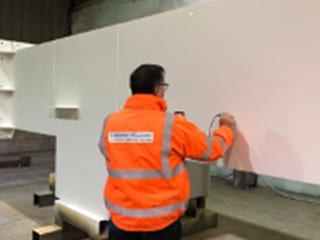
Latest News
In 2019 ICorr and the Hydrocarbon Passive Fire Protection Network (PFPNet) signed a collaborative agreement to develop an industry leading training course specifically aimed at Inspectors involved with the installation of hydrocarbon passive fire protection materials. Initially the course will be targeted at epoxy intumescent materials but will be quickly followed with further training relative to cement-based fire protection products.
PFPNet was chosen by ICorr as it is an independent industry group whose membership comprises a number of leading companies in the oil, gas and hydrocarbon processing industries, from owners to engineers, leading construction contractors, regulatory authorities, manufacturers of passive fire protection and contractors who apply these materials. The world leading expertise available through the PFPNet membership provided a high level of confidence for ICorr in assigning the development of this important training course them.
Passive fire protection is a critical item in personnel safety, it is also there to protect valuable assets against fire and by preventing escalation of an incident. However, to work correctly and maintain its integrity over the lifetime of an asset means it must be installed to the highest standards available, thereby making correct inspection of installation core to its success.
The hydrocarbon passive fire protection training course will, as indicated, be aimed at Inspectors responsible for installation of products, but it could equally benefit engineers and others who wish to understand the reason why passive fire protection is important, and the processes involved in its installation.
Key areas of the course
content include:
• Introduction to the types of passive fire protection (PFP) used and why it is important
• Types of structure that are protected by PFP
• Qualification and approval of PFP materials and the importance of ensuring compliance with project specification and regulatory requirements
• Installation of products from surface preparation through to final finish coat
• The impact of incorrect installation and defects, and how this affects both fire integrity and long-term performance
• Installation planning, importance of Quality Control at all stages and the responsibilities of the parties involved
• The role of the Inspector in ensuring a successful installation
The course is a full five-day programme and on the fifth day attendees will be required to complete an end of course examination, and their success will depend upon achieving sufficient marks against a defined set of questions.
ICorr and PFPNet believe that this training course will set a new standard in the industry for PFP inspection, and with cooperation of their respective members, particularly asset owners, will be looking to establish the course as the benchmark for inspector and engineer training.
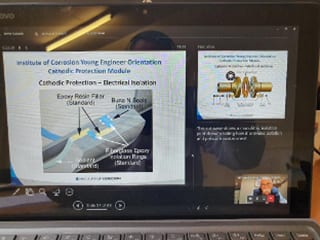
Latest News, YEP
The Young Engineer Programme once again displayed its adaptability as for its June meeting it adopted a new format for the online presentation, and welcomed the host Trevor Osborne for a discussion on cathodic protection.
The former President of ICorr and Managing Director of Deepwater Corrosion Services, with over 40 years of experience in oil and gas, shared his knowledge and specialised understanding in the new look presentation.
The adapted format saw the usual three-hour presentation replaced with it being sent a week in advance to the delegates. Trevor talked about corrosion, and the importance of the Galvanic Series, types of CP, standards and their importance, testing and inspection, failures and Field Joint Coatings.
Among other talking points, Trevor highlighted how electrical isolation in cathodic protection offers three main benefits, as it restricts the required protective current to the surface of the primary structure to produce a uniform polarised level of protection. It also minimises stray DC current interference and prevents galvanic current between metallic structures.
It was the decision to send the presentation to delegates in advance that proved to be the biggest revelation of the evening though, as it allowed questions to be prepared for the following Q&A session, with answers fielded by Trevor and collated by Principal Engineer at INTECSEA, Anthony Setiadi.
The knowledge displayed in the questions showcased the level of understanding within the industry with many of the questions prompting detailed answers from Trevor that caused him to draw from much of his considerable experience in the industry.
“I was extremely encouraged by the response from all of our delegates,” said Trevor Osborne when reflecting on the evening’s presentation. “and it shows the incredible level of interest and knowledge that the young people have within the industry. The future is certainly bright.”

Latest News
Digital Content Strategy – How Well Are We Doing?
When measuring how well a digital marketing strategy is progressing, there are many metrics which can be measured. However, we should remember the goals for our digital efforts – primarily to drive traffic to our website via organic acquisition (that is growth achieved by our content strategy, and not by paid means such as pay per click advertising).
It is this growth (for example in followers on LinkedIn) that we can market membership and training to – ICorr’s major business objectives.This review of our progress focuses on three metrics of growth:
• Website visits
• LinkedIn followers
• ‘Click-throughs’
Website Visits
We are posting content on our website to generate interest in ICorr and what we do, but if this is not interesting, informative, or enjoyable, visitors won’t engage with it, and we won’t encourage them to return. We want visitors to return as they are more likely to become engaged with our content and share it – and that promotes organic growth.
Visitor numbers
In the 30 days prior to this review, the ICorr website received 11,761 page views across 4,850 sessions – an increase of 11% and 21% on the previous 30 days respectively. The countries where most sessions derive from are, UK, USA, India, UAE, and Malaysia.
User numbers are up from 3,142 to 3,720, and new user numbers have improved from 2,787 to 3,325 over the period. Our highest ‘referral’ sources are LinkedIn and Facebook, with LinkedIn referred sessions increasing by 237% over the month and Facebook sessions by around 48%.
We will continue to post relevant content and link to social media accounts, and consider ways to further engage on social media to drive traffic to website.
Bounce rate
A bounce is when a visitor enters a page on a site but does not interact further – they don’t click through to a second or third page, or to other page elements. Average bounce rates depend upon the type of website. For example:
• Non-eCommerce content websites (probably the closest type to the ICorr website) can expect to have bounce rates between 35% and 60%
•Within the field of science, average bounce rates are around 53%
Our current bounce rate is 58%, so no cause for alarm, but a number that we will maintain a watchful eye on and seek to reduce by adding links to those pages and posts that currently have no links.
Session duration
This is the time a visitor spends on the website, from first clicking on it until they leave, or after 30 seconds of inactivity. The standard for session duration is two to three minutes, and we are currently right in the middle of this range. We are aiming to improve this by using various tactics, including using more images in content, and understanding the ‘customer journey’ better. However, the most important is to include links between pages on the website – people who are interested in the topic are more likely to click through and remain engaged on the site longer.
LinkedIn followers
As part of our content strategy, we have initiated a social media posting on the site strategy. The aim with this is to help share our content through social media, and encourage more people to follow it. By doing this we build a base that can become brand advocates, share our content further, and grow our membership and marketing potential. While we post to Facebook, Twitter, and Instagram, our focus and best results are on LinkedIn:
When we started with our content strategy at the beginning of February 2020, ICorr had zero followers on LinkedIn
•By the beginning of May, this number had increased to 997
•By mid-June 2020, we have seen another increase to 2,417
Our LinkedIn data allows us to segregate these under several headings. For example, by location, job function, seniority of role, and industry.
This information could be of incredible value when marketing – allowing ICorr to market in a more personalised fashion. For example:
• We now have 573 LinkedIn followers who are at entry level – how many of these could be potential ICorr members?
• We have 624 LinkedIn followers who work in the oil and gas industry – what training courses could we market to these?
• We have more than 300 LinkedIn followers who work at large firms (more than 10,000 employees). How can we encourage them to promote us within their firms?
Now that we have built a firm base, we can begin to explore ways in which we can market our memberships and training, including segmentation, email marketing, and targeted campaigns.
Click-throughs
Click-throughs are an indication of digital engagement with our membership. Focussing on LinkedIn again, we are experiencing industry-beating click through rates. A click-through is where a reader of one piece of content clicks through to a linked piece of content. It is usually associated with paid-for advertising campaigns (for example, pay per click adverts on Facebook) or landing pages on websites.
On LinkedIn, our click through rate (to other ICorr content on the ICorr website) was 4.4% in the first two weeks of July. The highest clickthrough rates are experienced in the dating industry! Technology has a click through rate of 2.09%, the average click through rate in eCommerce is 2.90%, and across all sectors, the average click through rate is 3.17% (data from wordstream).
We need to ensure that we continue to provide content that is relevant to our members and link appropriately.
In summary
Our digital strategy is continuing to drive traffic to the website and connect to a larger following on our social media. This is providing the opportunity to engage a larger target audience to whom ICorr can market its membership and training courses.


 Andrew Woodward and Chris Matthews wrapped up the week with a great talk on outcomes from their recent joint industry project (JIP) with Chevron and Woodside Petroleum, as part of a new technology development programme in line with DNVGL-RP-A203. They have recently developed a new patented method of sealing on the inside of a CRA clad or lined pipe, thus enabling a permanent subsea repair solution. The new seal in the “CLiP” Connector takes advantage of the corrosion resistant and ductile properties of Alloy 625 (UNS N06625) and experience gained through extensive testing of graphite in order to create a seal that conforms to NACE MR0175 / ISO15156-3. The seal forms around all pipeline manufacturing tolerances and even localised irregularities such as internal weld seams. The seal can be easily integrated into existing mechanical connector configurations and is able to be adapted for both diver installed and remote repairs. The technology qualification was completed through a combination of analysis (including development of a parametric FEA model to cover all future design scenarios), 3rd party material testing, and component testing in specialised test rigs; all culminating in full scale testing within a mechanical connector. The presentation focussed on the analysis and testing aspects of the technology qualification process which highlighted all key failure modes that had to be addressed.
Andrew Woodward and Chris Matthews wrapped up the week with a great talk on outcomes from their recent joint industry project (JIP) with Chevron and Woodside Petroleum, as part of a new technology development programme in line with DNVGL-RP-A203. They have recently developed a new patented method of sealing on the inside of a CRA clad or lined pipe, thus enabling a permanent subsea repair solution. The new seal in the “CLiP” Connector takes advantage of the corrosion resistant and ductile properties of Alloy 625 (UNS N06625) and experience gained through extensive testing of graphite in order to create a seal that conforms to NACE MR0175 / ISO15156-3. The seal forms around all pipeline manufacturing tolerances and even localised irregularities such as internal weld seams. The seal can be easily integrated into existing mechanical connector configurations and is able to be adapted for both diver installed and remote repairs. The technology qualification was completed through a combination of analysis (including development of a parametric FEA model to cover all future design scenarios), 3rd party material testing, and component testing in specialised test rigs; all culminating in full scale testing within a mechanical connector. The presentation focussed on the analysis and testing aspects of the technology qualification process which highlighted all key failure modes that had to be addressed.




